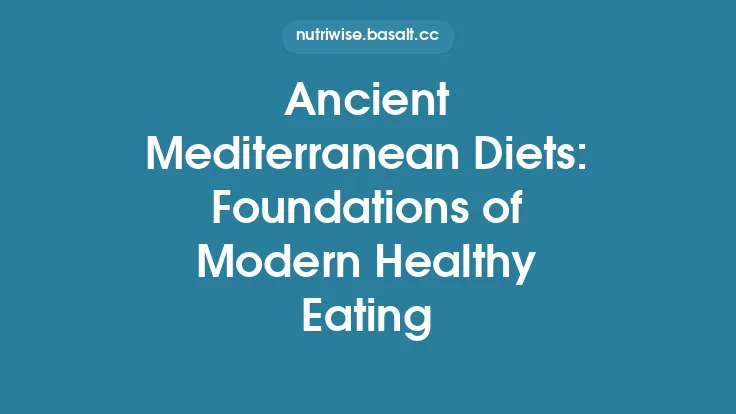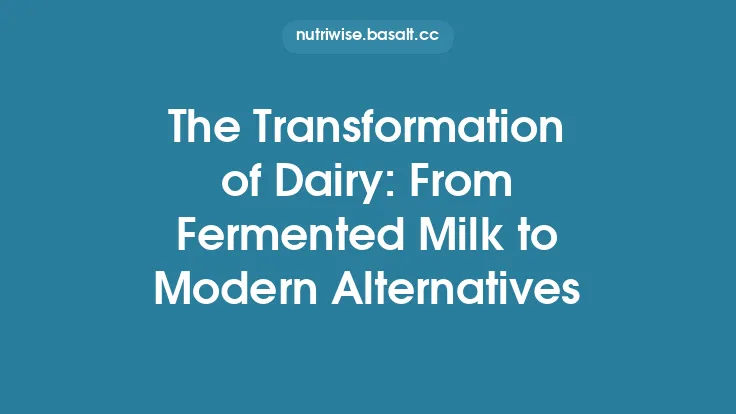The modern “Paleo” movement claims to revive the dietary patterns of our Paleolithic ancestors, arguing that contemporary health problems stem from a mismatch between our genetics and the foods introduced by agriculture and industrialization. While the concept is compelling, a rigorous evaluation requires separating the archaeological and physiological evidence from marketing hype and contemporary reinterpretations. This article dissects the foundational principles of Paleolithic nutrition, examines the scientific support for each claim, and highlights the practical implications for today’s eaters.
The Evolutionary Rationale Behind the Paleo Hypothesis
1. The “Mismatched Gene” Theory
The central premise of the Paleo hypothesis is that human DNA is largely unchanged since the end of the Pleistocene epoch (≈10,000 years ago). Consequently, the metabolic pathways that evolved to process wild game, tubers, fruits, and nuts are presumed to be optimal, whereas the rapid introduction of grains, legumes, dairy, and refined sugars is thought to outpace genetic adaptation.
Key points to consider:
- Genetic drift vs. selection pressure: While many genes have remained conserved, several loci (e.g., lactase persistence, amylase copy number) show clear evidence of recent positive selection, indicating that humans have indeed adapted to some agricultural foods.
- Phenotypic plasticity: Metabolic flexibility allows individuals to adjust enzyme expression and gut microbiota composition in response to dietary changes, mitigating the notion of a rigid “ancestral set point.”
- Population heterogeneity: Different hunter‑gatherer groups subsisted on markedly distinct macronutrient ratios (e.g., coastal foragers with high marine protein vs. inland groups relying on tubers). This variability suggests that there is no single “Paleo diet” that can be universally prescribed.
2. Energy Balance and Physical Activity
Paleolithic lifestyles were characterized by high levels of intermittent, vigorous activity interspersed with periods of rest. Energy expenditure was therefore highly variable, influencing macronutrient needs:
- Protein utilization: In a context of frequent, high‑intensity movement, protein served both as a structural component and a modest energy source, but carbohydrate intake from fruits and honey provided rapid fuel for bursts of activity.
- Fat storage: Seasonal scarcity prompted efficient fat storage mechanisms, a trait still evident in modern humans (e.g., the propensity for adipose tissue accumulation during caloric surplus).
Understanding these dynamics is essential when translating ancestral patterns to sedentary modern lifestyles, where total energy expenditure is dramatically lower.
Core Paleo Principles and Their Scientific Scrutiny
1. Exclusion of Grains and Legumes
Rationale in the original hypothesis: Grains and legumes contain antinutrients (phytic acid, lectins, protease inhibitors) that purportedly impair mineral absorption and gut integrity.
Current evidence:
- Phytic acid: While it can bind minerals, the effect is dose‑dependent and mitigated by food preparation methods (soaking, fermentation, sprouting). Moreover, phytic acid exhibits antioxidant and anticancer properties.
- Lectins and protease inhibitors: Most lectins are denatured by cooking; residual amounts in properly prepared foods are generally considered safe for the majority of the population.
- Fiber and microbiota: Whole grains and legumes are rich sources of fermentable fiber, supporting a diverse gut microbiome and producing short‑chain fatty acids (SCFAs) that confer metabolic benefits.
Overall, the blanket exclusion of these food groups lacks robust support, especially when considering the nutritional density they provide (e.g., B vitamins, magnesium, plant protein).
2. Emphasis on Lean Animal Protein
Original claim: Ancestral diets were high in protein from wild game, which is leaner and contains a different fatty acid profile than modern domesticated meat.
Scientific perspective:
- Protein quantity: Contemporary research suggests that protein needs plateau at ~1.6 g/kg body weight for most adults; excess intake does not confer additional muscle benefits and may increase renal load in susceptible individuals.
- Fatty acid composition: Wild game typically contains higher omega‑3 polyunsaturated fatty acids (PUFAs) and lower omega‑6 to omega‑3 ratios compared to grain‑fed livestock. However, modern sourcing (grass‑fed beef, pasture‑raised poultry, wild‑caught fish) can approximate these profiles.
- Red meat concerns: Epidemiological data link high consumption of processed red meat to increased cardiovascular risk, whereas unprocessed lean red meat, when consumed in moderation, shows a neutral or modestly beneficial association with nutrient status (iron, zinc, B12).
Thus, the principle of “lean animal protein” remains valid, but the emphasis should be on quality, sourcing, and portion control rather than an absolute exclusion of all other protein sources.
3. High Intake of Non‑Starchy Vegetables and Fruit
Paleo premise: Vegetables and fruit supplied essential micronutrients, antioxidants, and fiber, while being low in caloric density.
Evidence base:
- Micronutrient density: Dark leafy greens, cruciferous vegetables, and berries are among the richest sources of vitamins C, K, folate, and phytonutrients (e.g., flavonoids, carotenoids).
- Fiber and satiety: Soluble and insoluble fibers improve satiety, glycemic control, and colonic health.
- Fruit sugar content: While fruit contains fructose, the accompanying fiber and polyphenols attenuate rapid glucose spikes, making whole fruit a healthier option than isolated fruit juices or added sugars.
The principle aligns well with current dietary guidelines, reinforcing the importance of plant‑based micronutrient sources.
4. Inclusion of Nuts, Seeds, and Healthy Fats
Original assertion: Ancestral diets featured nuts and seeds as concentrated energy sources, providing essential fatty acids and fat‑soluble vitamins.
Modern validation:
- Monounsaturated and polyunsaturated fats: Almonds, walnuts, chia, and flaxseed deliver omega‑3 and omega‑6 fatty acids in ratios conducive to anti‑inflammatory pathways.
- Vitamin E and phytosterols: These compounds support lipid metabolism and cardiovascular health.
- Caloric density: Because nuts are energy‑dense, portion control is crucial to avoid unintended excess caloric intake.
The inclusion of these foods is widely supported, though the “unlimited” consumption sometimes promoted in marketing materials is not advisable.
5. Minimal Processed Foods and Added Sugars
Paleo stance: Processed foods introduce refined sugars, unhealthy fats, and additives that disrupt metabolic homeostasis.
Scientific consensus: Numerous studies link high intake of ultra‑processed foods to obesity, insulin resistance, and chronic disease. Reducing these items is a universally endorsed recommendation, independent of any specific dietary pattern.
Evaluating the Modern “Paleo” Market: What Has Shifted?
1. Commercialization and “Paleo‑Friendly” Labels
The rise of “Paleo‑approved” packaged products (e.g., granola bars, snack mixes, frozen meals) has introduced a paradox: foods marketed as Paleo often contain refined oils, added sugars, or artificial preservatives. Consumers must scrutinize ingredient lists, focusing on:
- Whole‑food content: Prioritize products where the first three ingredients are recognizable whole foods (e.g., nuts, dried fruit, grass‑fed meat).
- Added sugars and sweeteners: Look for minimal or absent added sugars; natural sweetness from fruit is acceptable.
- Processing level: Minimal processing (e.g., dehydrated vegetables, roasted nuts) aligns better with the original principle than heavily engineered formulations.
2. The “Paleo‑Keto” Hybrid
Some modern interpretations blend Paleo with very low carbohydrate approaches, drastically reducing fruit and starchy vegetables. While this may benefit specific metabolic conditions (e.g., refractory epilepsy), it diverges from the broader ancestral evidence that suggests a moderate carbohydrate intake from natural sources. The hybrid can lead to:
- Micronutrient gaps: Reduced fruit intake may lower vitamin C and potassium levels.
- Gut microbiome alterations: Low fiber diversity can diminish SCFA production, potentially affecting gut health.
3. Sustainability and Ethical Considerations
Ancestral diets were inherently sustainable due to low population density and reliance on wild resources. Scaling a modern Paleo diet to a global population raises concerns:
- Land use: High demand for animal protein can increase greenhouse gas emissions and require extensive pastureland.
- Biodiversity: Overharvesting of wild fish or game can threaten ecosystems.
A pragmatic adaptation emphasizes responsibly sourced animal products (grass‑fed, pasture‑raised, wild‑caught) and a greater proportion of plant‑based foods to balance ecological impact.
Practical Guidelines for a Balanced “Paleo‑Inspired” Eating Pattern
- Prioritize Whole Foods
- Base meals on unprocessed meats, fish, eggs, vegetables, fruits, nuts, and seeds.
- Use cooking methods that preserve nutrients (steaming, roasting, grilling) and avoid deep‑frying in refined oils.
- Select High‑Quality Animal Protein
- Opt for grass‑fed beef, pasture‑raised poultry, wild‑caught fish, and organ meats for nutrient density.
- Limit processed meats (sausages, cured products) due to added sodium and preservatives.
- Incorporate a Variety of Vegetables
- Aim for at least five different colors per day to maximize phytonutrient intake.
- Include both leafy greens (spinach, kale) and cruciferous vegetables (broccoli, cauliflower).
- Moderate Fruit Intake
- Choose low‑glycemic fruits (berries, apples, pears) and consume whole rather than juiced.
- Pair fruit with protein or fat (e.g., berries with Greek yogurt) to blunt glycemic response.
- Use Nuts and Seeds Wisely
- Limit to a handful (≈30 g) per day to control calories.
- Rotate varieties (almonds, walnuts, pumpkin seeds, chia) to diversify fatty acid profiles.
- Mindful Fat Choices
- Favor extra‑virgin olive oil, avocado oil, and animal fats from pasture‑raised sources.
- Avoid industrial seed oils (soy, corn, canola) that are high in omega‑6 PUFAs.
- Stay Hydrated and Include Electrolytes
- Water remains the primary beverage; herbal teas are acceptable.
- If carbohydrate intake is low, consider modest sodium and potassium supplementation (e.g., lightly salted broth, potassium‑rich vegetables).
- Listen to Your Body
- Monitor energy levels, satiety, digestive comfort, and biomarkers (lipid profile, fasting glucose).
- Adjust macronutrient ratios based on activity level, metabolic health, and personal tolerance.
Common Misconceptions and How to Address Them
| Misconception | Evidence‑Based Clarification |
|---|---|
| All grains are toxic | Whole grains provide fiber, B vitamins, and minerals. Antinutrients are reduced by cooking and fermentation. |
| Paleo eliminates all carbs | Ancestral diets included fruits, tubers, and honey, contributing 20‑35 % of total calories in many populations. |
| You must eat only meat | A balanced Paleo‑inspired diet includes a substantial proportion of vegetables and fruits, which supply essential micronutrients and fiber. |
| Paleo is automatically weight‑loss friendly | Weight change depends on total energy balance; overconsumption of nuts, oils, or meat can lead to surplus calories. |
| Paleo is a one‑size‑fits‑all plan | Genetic, cultural, and lifestyle differences mean that macronutrient needs vary; personalization is key. |
Integrating Paleo Principles with Contemporary Nutrition Science
The most constructive approach is to view Paleo not as a rigid prescription but as a framework emphasizing:
- Whole, minimally processed foods – a principle shared across most evidence‑based dietary guidelines.
- High nutrient density – focusing on foods that deliver vitamins, minerals, and bioactive compounds per calorie.
- Balanced macronutrients – allowing flexibility to adjust protein, carbohydrate, and fat ratios based on individual needs.
When combined with modern insights—such as the role of the gut microbiome, the importance of dietary diversity, and sustainability considerations—these principles can inform a resilient, health‑promoting eating pattern that respects both our evolutionary heritage and present‑day realities.
Concluding Thoughts
The allure of returning to an “ancestral” way of eating stems from a legitimate concern: the rapid dietary shifts of the past century have coincided with rising chronic disease rates. However, the scientific record shows that human nutrition has always been adaptable, and that the Paleolithic diet itself was far from monolithic. By extracting the timeless elements—whole foods, nutrient density, minimal processing—and discarding the oversimplifications and marketing distortions, we can craft a pragmatic, evidence‑grounded approach that honors our evolutionary past while meeting the demands of modern life.





